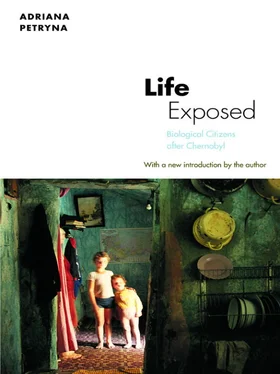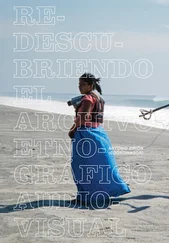• • •
The Soviets rejected Western offers to help assess the meteorological situation. (Tom Sullivan offered his team’s assistance through a Swedish intermediary, but his offer was refused.) Within the Soviet Union, a special military radiological service was charged with the task of monitoring radiation levels around the plant. [8] The Soviets had a large network of radiation-monitoring stations.
No information was released (Medvedev 1990:46). The service finally presented crude data, indicating the distribution of the plume within the Soviet Union, in its August 1986 report to the International Atomic Energy Agency (IAEA). In that report, the Soviet State Committee on the Utilization of Atomic Energy made a seemingly definite statement:
None of the populations received high doses that would have resulted in acute radiation syndrome…. On the basis of an analysis of the radioactive contamination of the environment in the Zone, assessments were made of the actual and future radiation doses received by the populations of towns, villages, and other inhabited places. As a result of these and other measures, it proved possible to keep exposures within the established limits. (USSR State Committee on the Utilization of Atomic Energy 1986:38)
As Medvedev reported, radiation on the ground “was well in excess of the scales on the available dosimetric equipment” (1990:45). He also noted that “in some spots… it killed four hundred hectares of pine forest within a matter of days” (103). Skeptical of Soviet claims that no genetic effects from Chernobyl could ever occur, Medvedev wrote, “Pine trees may be more sensitive to radiation than oak trees, but they are much more resistant than rodents and vertebrates in general” (ibid.).
Buttressed by crude maps, the Soviet truth (as presented to the IAEA) prevailed above and beyond observable evidence and realities of the plume; that truth authorized a domain of government activity and limited intervention. Facts that did not support this domain were either disregarded or eliminated. For example, a follow-up report from the Soviet-American bioscientific collaboration (which I will discuss shortly) stated that “external measurements were unavailable at the time of the accident; they were either not designed for these levels of radiation or were destroyed or lost as a consequence of circumstances associated with this accident” (Baranov et al. 1989:205). [9] The initial Soviet report to the IAEA in August 1986 stated that “environmental monitoring devices, or individual radiation meters or badges, were of limited value at Chernobyl.” IAEA, Soviet State Committee on the Utilization of Atomic Energy 1986. The Accident at Chernobyl Nuclear Power Plant and Its Consequences. Information compiled for the IAEA Experts’ Meeting, August 25–29, 1986, Vienna. Working Document for the Post-Accident Review Meeting.
My interview with Sullivan’s ARAC team, together with the information detailed above, underscores the constructed nature of the unknown in this setting. A catastrophe whose scale was unimaginable, difficult to map, and “saturating” became manageable through a particular dynamic: non-knowledge became crucial to the deployment of authoritative knowledge, especially as it applied to the management of exposed populations.
Institute of Biophysics, Moscow
Information about the radioactive explosion and fire was transmitted to the Soviet Ministry of Health in Moscow. Angelina Guskova, chief radiologist of Clinic No. 6 of the Institute of Biophysics, was contacted one hour after the initial explosion, “on my phone at home, I was in my bed,” she told me in 1996. Guskova and her colleague, Aleksandr Baranov, were charged with organizing emergency aid measures, providing biomedical care, treatment, and monitoring for the first victims of the disaster.
Guskova was trained as a hematologist and neurologist; both skills would serve her well in this situation. She has been a member of UNSCEAR (UN Scientific Committee on the Effects of Atomic Radiation) since 1967, and she worked under Professor L. A. Ilyin, chairman of the Soviet Radiological Protection Board and director of the Institute of Biophysics in Moscow. Since the mid-1950s, Guskova and her colleagues had been engaged in the clinical study of radiation effects in humans. Prior to working at Clinic No. 6, she headed the Neurological Division of Medical Services of the Mayak nuclear plant, a munitions industry complex producing plutonium in the once closed city of Cheliabinsk, the capital of the southern Ural region. This area had been wrecked by two nuclear disasters, both of which were covered up by the Soviet government. The first one lasted a decade, when, beginning in 1951, the Mayak plant began dumping waste from nuclear bomb production into a small lake. [10] The lake evaporated, leaving behind dangerous doses of radioactive dust.
In 1957, a failure in the nuclear waste cooling system at the nearby Kyshtym plant released at least seventy tons of waste containing about twenty million curies of radioactivity—roughly one-fourth the amount released in the Chernobyl accident.
Guskova oversaw research involving two hundred individuals who became part of her official Acute Radiation Sickness (ARS) cohort. Until Chernobyl, this group was considered to be the largest cohort of ARS patients in the world. [11] They had been exposed to radiation from weapons testing and other nuclear accidents, such as the one in the Urals in the 1950s.
Her clinical experience was multifaceted, reflecting the variety of radiation-related injuries these workers experienced, from direct contact with ionizing sources to inhalation and whole body exposure. She developed surgical procedures for removing radiation-induced lesions and scars. She established medical classifications and methods for clinical observation of occupational radiation-related diseases. She developed the protocols for clinical monitoring and legal-medical evaluation. In short, Guskova “formulated radiobiological questions which could only be answered by the clinical observation [of man]” (1997:604). [12] She was noted for her efforts to combine radiobiology with clinical medicine. See Guskova 1997.
Guskova also formulated what she referred to as a “semi-empirical model” for estimating dose exposures in cases where doses were not known. This model was based on an examination of patients’ external symptoms and linked the time of symptom appearance to an estimation of dose. Based on this model, she organized treatments and projected patients’ recovery or death. [13] According to Medvedev, “There was no proper agreed scientific method in the Soviet Union for making these estimates. Different experts used different approaches” (1990:130).
Acute radiation sickness occurs at dose ranges between 200 and 400 rem. At 400 rem, bone marrow failure sets in. Up to approximately 1,000 rem, there is a chance for survival with intensive treatment.
ARS consists of a series of clinical events (“syndromes”). These syndromes include the central nervous system syndrome, characterized by an onset of apathy, lethargy, seizures, ataxia, and prostration, appearing immediately after exposure. The gastrointestinal syndrome is characterized by anorexia, nausea, vomiting, fever, and severe systemic infections. These symptoms manifest within a few days to a few weeks after exposure. The hematopoietic or bone marrow syndrome is characterized by an absolute fall of the patient’s peripheral lymphocyte and granulocyte count and by an increase in leukocyte counts. Changes in these blood indicators can occur within the first few hours of exposure; they can keep fluctuating over several months, and, some say, over an individual’s lifetime.
Читать дальше












